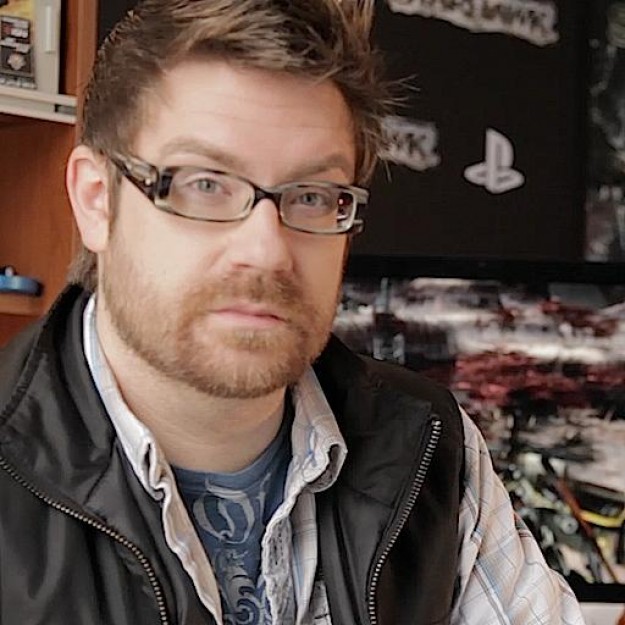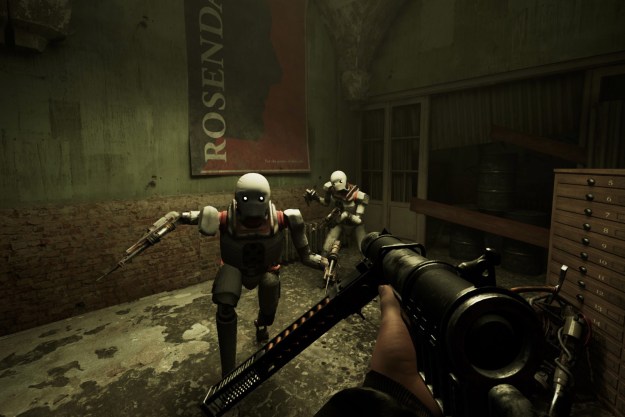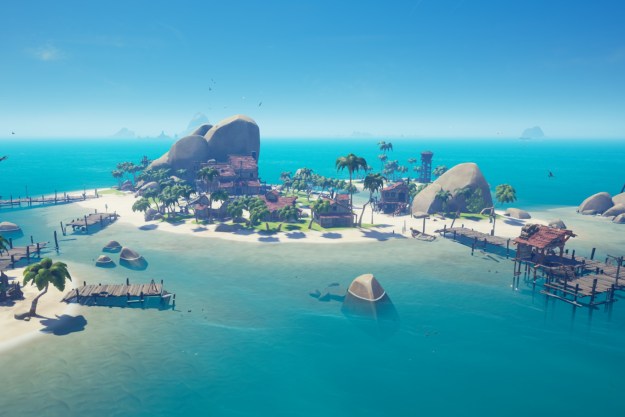 With Starhawk releasing on the PlayStation 3 this week, there are few people quite as busy as Dylan Jobe, President of LightBox Interactive, developers of the game. From his days as a designer at National Cash Registry to his rise through the ranks of the gaming industry towards founding his own studio, Jobe has had a front row seat to the maturation of the industry, giving him a unique perspective.
With Starhawk releasing on the PlayStation 3 this week, there are few people quite as busy as Dylan Jobe, President of LightBox Interactive, developers of the game. From his days as a designer at National Cash Registry to his rise through the ranks of the gaming industry towards founding his own studio, Jobe has had a front row seat to the maturation of the industry, giving him a unique perspective.
We had the chance to speak with Job about the birth of Starhawk, helping to found his own company, and how the industry is beginning to fragment.

Originally I went to design school, studied product design, and worked for AT&T and National Cash Register of all companies, doing product design and software design, and all that stuff. That’s kind of where I was going in my career. I always loved video games in a dusty, stogy corporate environment. I kept bringing video games into the workplace. If you can imagine a bunch of engineers and designers at National Cash Register playing Quake on lunch. I remember getting this little corporate award for team building through acts of internet violence. Then I just thought to myself, you know, I love games, I was using the editors at home to make games, and that’s what I really wanted to do. I was actually in a pretty good place in my career, but I said screw it.
I then left NCR and moved out to Utah where I worked for a company that has long since passed called SingleTrac, and worked SingleTrac for a while. When SingleTrac started to have issues, I was thankfully rescued by Scott Campbell, who is President of Incognito Entertainment. Then I worked Incognito on Twisted Metal Black, War of the Monsters, and Warhawk. Then recently started our own company with some of my business partners and longtime colleagues, some of them even going back to SingleTrac days. We started a new company in Austin, Texas which was Lightbox Interactive, and our first game was Starhawk.
I talked with Jaffee about that not long ago, and he spoke fondly of his SingleTrac days.
Those were crazy days. That was a very different time in game development, that’s for sure.

So how did you go about founding LightBox?
The biggest contributor to that was that we had a really great relationship with Sony Santa Monica. I had been working with Sony Santa Monica, even on Twisted Metal Black where I just did environment, textures, and models of vehicles as a 3D artist, then eventually worked my way up to directing and producing War of the Monsters and on to Warhawk. I just had a really great relationship with the Sony Santa Monica guys, and they had mentioned all along the way ‘if you ever want to go off and do your own thing, definitely talk to us.”
I always had kind of a 10-year goal that I wanted to do once I got into the gaming industry and kind of felt it out. I was very fortunate to make some great professional friendships with a number of people that covered all the gamuts of game development. My tech director Bruce Woodard, who I’d worked with way back at SingleTrac, our creative director Lars DeVour, who I also worked with at SingleTrac.
We were able to form a company, that instead of just me being the one owner, we are all owners. And I think it actually creates a really great structure for the company, and it benefits our employees and our publisher, because it’s not just one guy making decisions, we have all the different developments of game development from all the owners of the company, so we collectively make really good decisions that benefit our employees, and ultimately benefit Sony Santa Monica.
How many people do you have working at LightBox?
I think we’re only at 43 employees at LightBox Interactive, so pretty small by contemporary big shooter standards.
Do you think there is a shift towards more, smaller developers, or are the big guys always going to be the dominant, moving force of the industry?
It’s going to be a very interesting next couple of years. I think that for those publishers that can really double down with big budgets and big marketing, they’re always going to be successful in traditional brick and mortar distribution. But I think you’re going to see a lot more smaller teams, but they are going to be using the more democratized distribution models. Just like you are seeing with Android and iPhone, and even more so with other handhelds. I think you are going to see a proportionately larger distribution of smaller developers, but those teams that still linger in the mega triple-A space, in order to even matter you’re going to have to be really big. And quite frankly that was a really scary decision and discussion we had internally with our employees at LightBox Interactive, and also with Sony Santa Monica. Because here we are making a shooter, which is the most stacked genre—I mean you’ve got Halo, Battlefield, Call of Duty, Gears—those are all amazing titles, enormous budgets. How are we going to compete? And we knew we didn’t have the budgets like they had. We knew we didn’t have the team size.
What’s your take on the growing kickstarter movement?
The kickstarter thing is really interesting. Obviously, Tim [Schafer] got a lot of attention from the stuff they were doing at Double Fine. And you’ve seen a remake that got a fair amount of funding, Shadowrun.
Here’s the thing, in many respects you can compare a Wal-Mart and an Etsy model. Etsy allows a variety of small companies and people to produce content and sell it. It very much breaks down the traditional barriers for distribution that used to only be held by big companies. That’s not rocket science, we’ve been talking about that for years, but that same parallel is showing up in kickstarter, and it’s showing up in games. And those barriers, whether they are for video games, or crafts on Etsy, or whether it’s for broadcast television on YouTube, or Twitch, or Ustream, that is a trend that is unstoppable. And that is absolutely going to continue.

So getting back to Starhawk, how do you compete toe-to-toe with the big budget shooters?
We’ll tell you after the first couple months of sales to see if we were able to. Let’s be honest: Starhawk was a risky game for us to make. Like I said, we are jumping into the most competitive genre. Our strategy was “well, let’s just to go balls out and try something new.”
The way we do our building structures in the game is very new, certainly. But there are hints of it that have shown up in many games in the past. There were many games that tried to integrate some of those elements, that tried to blend some of the RTS stuff in with the shooter. What’s really interesting with what we did with Starhawk is that we kind of took the opposite approach than many other teams. Some studios that have tried to throw RTS and shooter into a blender and mix it up into a product, have been predominantly strategy teams that have tried to bring shooter gameplay. But we took the opposite approach. We were the Warhawk team. We took the shooter gameplay and tried to bring in the appropriate strategy elements.
Our leading maxim throughout the integration of the build-and-battle and real-time strategy elements was we didn’t want you to have to manage things, we didn’t want you to have to manage things, we didn’t want you to have to go and do all of the stuff that felt slow and laborious for real-time strategy games. We wanted to make building structures as quick and visceral as pulling the trigger on a gun.

Oh my God, tons of stuff. I think it’s important for people keeping up with game development to know that it is not a process where a game designer creates a three inch thick design bible, and that it just gets created. It’s not like that, at all. There are tons of prototypes and edits.
Even with build-and-battle itself, we did so many prototypes. Hell, we had a version that we tried out in build-and-battle that was grid based, and you would build without combat, and you would fight in combat, and then you would build, and then you would fight. That was just one prototype that unto itself was kind of cool, but it didn’t have great pacing, it didn’t have that “oomph”—that adrenalized oomph that shooter fans were gonna get. So that was one particular prototype that we were like “we see the potential here, I love being able to run around structure I just built, but this isn’t working. The pacing isn’t right, there are still these experiential speed bumps.” So we scrapped that one.
There were a bunch of different environments and build-and-battle structures in the game that we brainstormed and conceived that ultimately didn’t make the cut. Maybe someday they’ll come back in DLC, but quite frankly I think what we are going to do is just look for a couple of weeks of gameplay once we go live, and see what units we should release to supplement any potential holes or voids in our design, once players get their hands on it.
These days it is almost expected that games will offer DLC. How do you approach a development knowing there will be more content to be released later?
Nowadays, for you to be competitive at retail you have to give some retailers an incentive. We did the same with Starhawk, we’ve got a great limited edition pack for your pre-order that has a bunch of exclusive stuff in it. But as far as getting the jumpstart on additional missions, or story content, or new vehicles, or build-and-battle structures, we actually waited until the very, very end. Starhawk was done and sent off to the final testing phases in Sony before we really started digging in to ideas we might want to pursue for DLC.
It is almost commonplace now for publishers—sometimes DLC for a game gets put up on a store before the game hit retail. That’s not really our approach.
For the big DLC, like if we release a new vehicle, or a new structure to build in the game, we want to make sure that is influenced by the player community. We don’t want to make any assumptions, like “after you’ve played the game for a month, you’re going to want Voltron.”
So we’ve got a bunch of ideas that are floating around the studio, and as we see the gameplay pan out over the next couple of weeks, we’ll have a pretty good idea of which way to go with our DLC. But as players saw on Warhawk, and during the Starhawk beta, we are very very good at doing updates, and staying in touch with our community. So we have a number of things that are planned that are completely free updates for players to make sure that everything stays balanced and fresh. The term is “sticky,” you want to try and keep your gameplay community sticky. You do that by taking good care of your community.

We’re already looking at a bunch of exciting new opportunities with Sony, so that’s great for LightBox Interactive. At the same time, we have a contract already in place to continue to do updates, including free updates for our player community. Sony Santa Monica and LightBox Interactive are very dedicated to the fans. So that contract is already in place.
What are you most proud of in this game?
I’m most proud of the build-and-battle system. If you were to distill the game down into one marketing nugget, it was trying to do something new in the shooter genre with the build-and-battle system.
So now that the game is launching, how much pressure do you feel?
There’s a lot of pressure, sure. You’re talking about a game that has an international, simultaneous release. You’re talking about releasing Starhawk in 22 languages all over the globe. So there is certainly high stress there, but on top of that, there’s the stress of–you never know how it’s going to go. We really changed things up. Will players that are fans of traditional shooters—will Starhawk be a game they want to play?
It’s a game that we all really love, and it went over well in the beta, but you never know. When you see the reviews come in and you see the sales figures… there are so many variables, you can never tell.

I do actually see the gaming industry down in certain markets. We were very, very fortunate to start a studio, based on the great relationship we had with Sony Santa Monica, and that allowed us to build a studio during an economic downturn. So there was a really cost effective way of building a company. But right now there’s a fork in the road, I think, that is sitting in front of a lot of developers. Can you get the funding, and the support, and the staff size to be competitive in traditional genres brick and mortar retail, or do you go a more nimble and contemporary software development approach?
I think the next few years are going to be very interesting for console makers. That includes Microsoft, Sony, and Nintendo.
So which way do you think the industry is heading?
I think it is going to become even more polarized. I think you are going to see a drop in the number of products that are sold traditionally at stores, and those are going to be big budget games. It’s just the real, difficult truth that in order to be competitive, you either need to be something that is a radical breakout, or you have to have this juggernaut of support to mass inject society with the brand.
I think you are going to see it polarize there, you are going to see far fewer titles on that side. And I think you are going to see that everyone is going to rush into the smaller scene, whether it is web game, Facebook games, or all the other more publicly available distribution models. I think that is going to continue to grow. And I think it is going to continue to polarize the industry.


